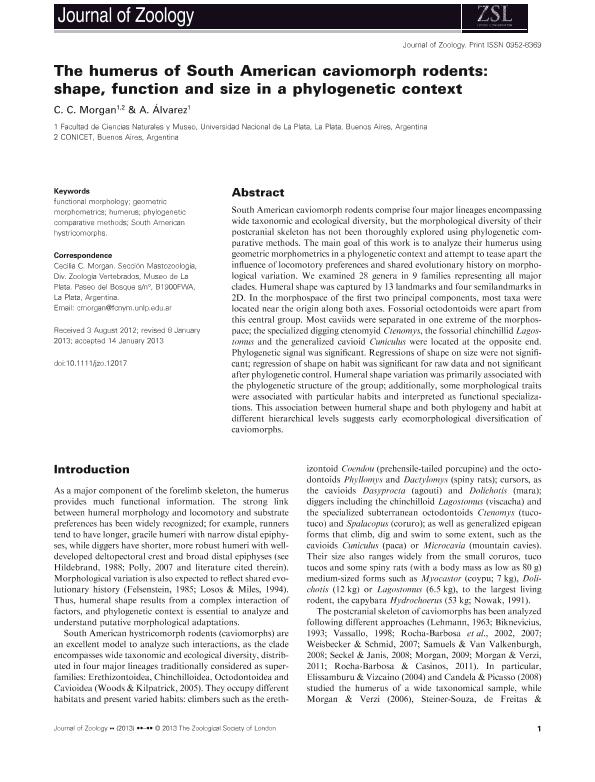Mostrar el registro sencillo del ítem
dc.contributor.author
Morgan, Cecilia Clara

dc.contributor.author
Alvarez, Alicia

dc.date.available
2020-04-01T16:39:53Z
dc.date.issued
2013-06
dc.identifier.citation
Morgan, Cecilia Clara; Alvarez, Alicia; The humerus of South American caviomorph rodents: Shape, function and size in a phylogenetic context; Wiley Blackwell Publishing, Inc; Journal Of Zoology; 290; 2; 6-2013; 107-116
dc.identifier.issn
0952-8369
dc.identifier.uri
http://hdl.handle.net/11336/101531
dc.description.abstract
South American caviomorph rodents comprise four major lineages encompassing wide taxonomic and ecological diversity, but the morphological diversity of their postcranial skeleton has not been thoroughly explored using phylogenetic comparative methods. The main goal of this work is to analyze their humerus using geometric morphometrics in a phylogenetic context and attempt to tease apart the influence of locomotory preferences and shared evolutionary history on morphological variation. We examined 28 genera in 9 families representing all major clades. Humeral shape was captured by 13 landmarks and four semilandmarks in 2D. In the morphospace of the first two principal components, most taxa were located near the origin along both axes. Fossorial octodontoids were apart from this central group. Most caviids were separated in one extreme of the morphospace; the specialized digging ctenomyid Ctenomys, the fossorial chinchillid Lagostomus and the generalized cavioid Cuniculus were located at the opposite end. Phylogenetic signal was significant. Regressions of shape on size were not significant; regression of shape on habit was significant for raw data and not significant after phylogenetic control. Humeral shape variation was primarily associated with the phylogenetic structure of the group; additionally, some morphological traits were associated with particular habits and interpreted as functional specializations. This association between humeral shape and both phylogeny and habit at different hierarchical levels suggests early ecomorphological diversification of caviomorphs.
dc.format
application/pdf
dc.language.iso
eng
dc.publisher
Wiley Blackwell Publishing, Inc

dc.rights
info:eu-repo/semantics/openAccess
dc.rights.uri
https://creativecommons.org/licenses/by-nc-sa/2.5/ar/
dc.subject
functional morphology
dc.subject
geometric morphometrics
dc.subject
humerus
dc.subject
phylogenetic comparative methods
dc.subject
South American hystricomorphs
dc.subject.classification
Zoología, Ornitología, Entomología, Etología

dc.subject.classification
Ciencias Biológicas

dc.subject.classification
CIENCIAS NATURALES Y EXACTAS

dc.title
The humerus of South American caviomorph rodents: Shape, function and size in a phylogenetic context
dc.type
info:eu-repo/semantics/article
dc.type
info:ar-repo/semantics/artículo
dc.type
info:eu-repo/semantics/publishedVersion
dc.date.updated
2020-03-30T16:29:06Z
dc.journal.volume
290
dc.journal.number
2
dc.journal.pagination
107-116
dc.journal.pais
Reino Unido

dc.journal.ciudad
Londres
dc.description.fil
Fil: Morgan, Cecilia Clara. Consejo Nacional de Investigaciones Científicas y Técnicas. Centro Científico Tecnológico Conicet - La Plata; Argentina. Universidad Nacional de La Plata. Facultad de Ciencias Naturales y Museo. Departamento Científico Zoología Vertebrados; Argentina
dc.description.fil
Fil: Alvarez, Alicia. Universidad Nacional de La Plata. Facultad de Ciencias Naturales y Museo. Departamento Científico Zoología Vertebrados; Argentina. Consejo Nacional de Investigaciones Científicas y Técnicas. Centro Científico Tecnológico Conicet - La Plata; Argentina
dc.journal.title
Journal Of Zoology

dc.relation.alternativeid
info:eu-repo/semantics/altIdentifier/url/http://onlinelibrary.wiley.com/doi/10.1111/jzo.12017/abstract
dc.relation.alternativeid
info:eu-repo/semantics/altIdentifier/doi/http://dx.doi.org/10.1111/jzo.12017
Archivos asociados
